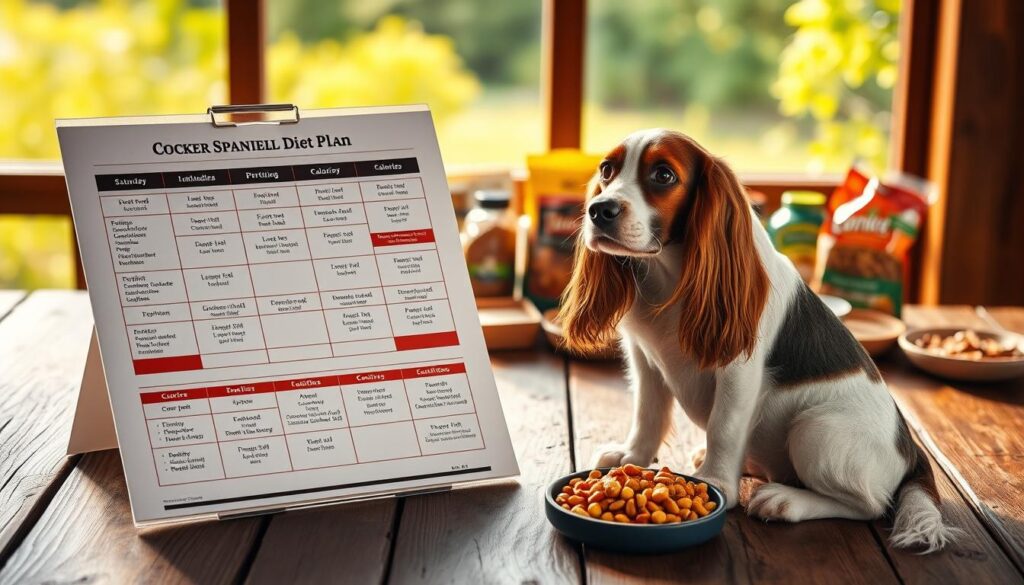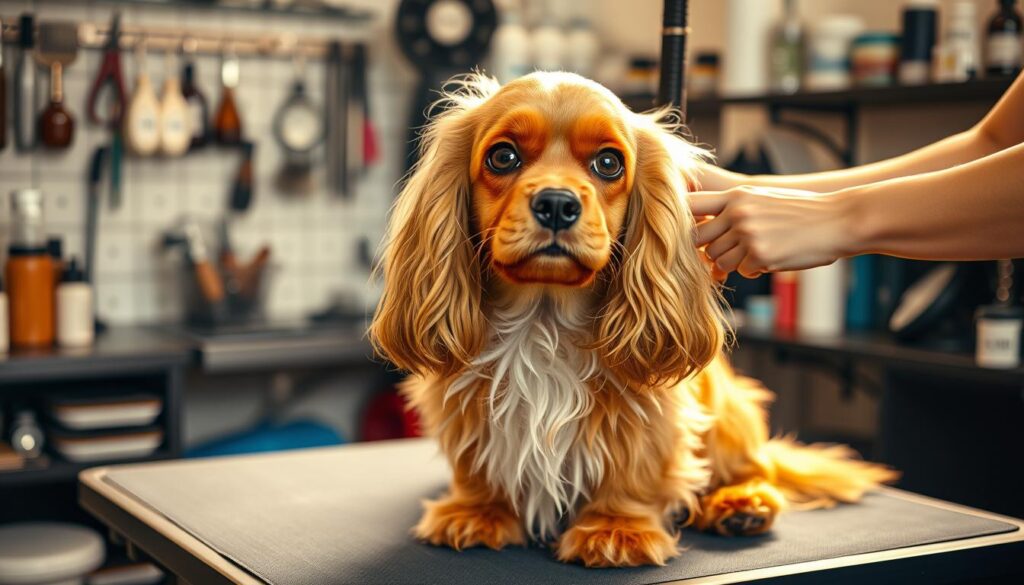With their soulful gaze and cheerful demeanour, these medium-sized dogs have charmed Australian families for decades. Originally bred as skilled hunting companions in Spain, their intelligence and adaptable nature now make them ideal household pets. Their soft coats and wagging tails hide a rich history of working alongside humans, blending practicality with affection.
The breed’s gentle temperament stems from centuries of selective breeding. Trainability and loyalty remain central to their personality, traits once vital for fieldwork. Today, this translates into a dog that thrives on companionship and responds well to positive reinforcement.
Understanding their needs is key to nurturing a happy pet. Regular grooming maintains their signature silky coat, while mental stimulation prevents boredom. Their social nature means they flourish in active homes where they feel included in daily routines.
Key Takeaways
- Originated as Spanish hunting dogs before becoming family favourites
- Intelligent nature requires consistent training and engagement
- Regular coat care prevents matting and skin issues
- Thrives on human interaction and structured routines
- Balanced diet and exercise support long-term health
Introduction
Australian households have long cherished a particular four-legged friend known for its adaptability and intelligence. This breed thrives when owners understand its physical and emotional needs, which is where our definitive resource comes into play.
Overview of the Ultimate Guide
Our manual combines veterinary science with practical advice tailored to Australian climates and lifestyles. You’ll discover strategies for nutrition, exercise routines, and mental enrichment that align with the dog’s natural instincts. The table below highlights key focus areas:
| Focus Area | Benefit | Action |
|---|---|---|
| Nutrition | Supports joint health | Choose grain-free options |
| Training | Builds trust | Use reward-based methods |
| Health Checks | Prevents ear infections | Weekly inspections |
Why This Guide is Essential
Many owners underestimate the importance of structured routines for this dog. Our guide addresses gaps in mainstream advice, such as managing separation anxiety in humid climates. It also clarifies common misconceptions about coat maintenance and energy levels.
Backed by case studies from Sydney to Perth, the recommendations adapt to urban apartments or rural homes. Whether mastering recall techniques or selecting chew toys, every tip prioritises your companion’s wellbeing.
History and Heritage of the Cocker Spaniel
From Roman battlefields to English estates, this breed’s journey mirrors human history itself. Their story begins in ancient Spain, where ancestors with distinctive long ears hunted alongside Phoenician traders over 3000 years ago. Roman armies later transported these skilled hunting dogs across Europe, laying foundations for regional varieties.
Breed Origins and Early Development
By 43 AD, early spaniel-type dogs reached Britain through military campaigns. Specialising in flushing game birds from thickets, they earned the “cocker” title from their woodcock-hunting prowess. Breeders prioritised traits like compact size and soft mouths to retrieve prey unharmed.
Eighteenth-century records show distinct differences between land and water varieties. The smaller land spaniels excelled in dense undergrowth, their silky coats protecting against brambles. This period solidified their reputation as indispensable partners for hunters.
Evolution From Hunting Dog to Family Companion
Victorian-era enthusiasts began refining the breed for both fieldwork and temperament. Selective breeding enhanced their natural gentleness while retaining sharp instincts. As firearms replaced nets in hunting, their role shifted towards retrieving downed birds.
Post-World War II Australia saw growing demand for adaptable family pets. The spaniel’s trainable nature and moderate energy suited suburban living. Today, their heritage as hunting dogs surfaces through playful retrieves and keen scent-tracking during beach walks.
Exploring the “cocker spaniel eager to please” Personality
What truly defines these affectionate companions lies in their instinctive drive to connect with people. Their sunny outlook and responsive behaviour make them stand out in multi-pet households or busy family settings.
Understanding Their Natural Temperament
Centuries of working alongside hunters forged a temperament built on cooperation. This heritage surfaces in their attentive gaze and readiness to follow cues. Positive reinforcement strengthens this bond, turning everyday interactions into rewarding experiences.
Their social personality thrives on consistent routines and gentle guidance. Early socialisation helps channel their enthusiasm constructively, preventing overexcitement around children. While generally adaptable, sudden changes in environment may trigger nervous behaviours that require patient reassurance.
Intelligence shines through their problem-solving skills during play or training sessions. Owners often notice how quickly they master commands when praised. This nature makes them ideal candidates for therapy work or agility competitions where mental stimulation meets physical activity.
Balancing their sensitive side with clear boundaries ensures confidence grows. Harsh corrections contradict their eager-to-please disposition, potentially leading to withdrawn behaviour. Instead, reward-based methods align perfectly with their desire to make humans happy.
Key Characteristics of the Breed
A harmonious blend of form and function defines this beloved companion’s build. Their medium frame balances sturdiness with elegance, reflecting their heritage as both hunters and home companions. Owners appreciate how their proportions suit Australian lifestyles – compact enough for city living yet robust for beach adventures.
Physical Dimensions and Structure
Mature adults stand 35-41 cm tall at the shoulder, weighing 11-15 kg. This breed develops full height by 12 months but gains muscle definition until age two. Their deep chest and strong legs enable swift movement, while feathered paws protect against rough terrain.
Signature Attributes
The coat remains their crowning glory – silky waves in solids or parti-colours require weekly brushing. Those expressive dark eyes seem to mirror emotions, earning them a reputation as intuitive partners. Long, lobular ears demand vigilance against infections, particularly in humid regions.
| Trait | Description | Maintenance Tip |
|---|---|---|
| Coat Type | Moderate-shedding double layer | Brush 3x weekly |
| Ear Length | Reaches jawline | Clean weekly with vet-approved solution |
| Eye Shape | Almond-shaped, dark | Wipe corners daily |
This dog’s appearance combines practicality with beauty. The weather-resistant coat protects during outdoor activities, while those iconic ears – though charming – need regular checks. Understanding these traits helps owners maintain both health and that signature breed charm.
Health Considerations and Preventative Care
Proactive care helps these loyal companions maintain their signature zest for life. While generally robust, their unique physiology requires tailored attention to prevent common health issues. Early intervention and routine checks form the foundation of lifelong wellbeing.
Common Health Issues to Monitor
Joint concerns like hip dysplasia often emerge in active dogs. Maintaining lean body weight through measured meals reduces strain on limbs. Regular low-impact exercise, such as swimming, supports mobility without overexertion.
Skin sensitivities rank among the most frequent health challenges. Omega-rich diets combat dryness, while weekly brushing distributes natural oils. Watch for excessive scratching – early treatment prevents secondary infections.
Maintaining Overall Wellbeing
Annual eye exams detect cataracts before they impair vision. Breeders conducting genetic testing significantly lower inherited health issues risks. Consider these preventative strategies:
| Focus Area | Action | Benefit |
|---|---|---|
| Nutrition | High-quality protein sources | Supports muscle health |
| Exercise | Daily mental stimulation | Prevents obesity |
| Grooming | Ear cleaning routine | Reduces infection risk |
Establishing trust with a vet familiar with the breed ensures personalised care. Recordkeeping helps track emerging patterns – note energy shifts or appetite changes promptly. With proper management, these dogs typically enjoy 12-15 vibrant years.
Nutritional Needs and Feeding Guidelines
Balanced meals fuel both body and mind in active companion dogs. Tailoring meals to their energy requirements prevents common health issues while supporting their natural vitality. Let’s explore how smart food choices create thriving pets.

Building Blocks of Optimal Nutrition
Fresh, whole-food ingredients deliver nutrients synthetic supplements can’t match. Kangaroo meat provides lean protein ideal for muscle tone, while sardines supply joint-nourishing omega-3s. Fennel seeds aid digestion – a common concern in food-sensitive breeds.
“Real food diets reduce allergy risks by 40% compared to processed kibble,” notes Dr. Emily Carter, Sydney-based veterinary nutritionist.
Smart Feeding Strategies
Portion control prevents weight gain that strains joints. Use measured cups rather than free-feeding. Puppies need 3-4 small meals daily, transitioning to twice-daily feeds by six months. Consider this guide:
| Weight Range | Daily Food | Key Nutrients |
|---|---|---|
| 5-8 kg | 150-200g | Chicken, pumpkin |
| 9-12 kg | 220-280g | Kangaroo, sweet potato |
| 13-15 kg | 300-350g | Fish, green beans |
Adjust portions based on activity levels. Overweight dogs benefit from low-calorie veggies replacing 10% of their diet. Always provide fresh water – dehydration mimics hunger cues.
Training Your Cocker Spaniel: Positive Techniques
Successful training transforms energetic companions into attentive partners. This breed’s natural responsiveness shines when owners combine patience with clear communication. Reward-based methods align perfectly with their cooperative spirit, turning lessons into bonding opportunities.
Building Skills Through Engagement
Short 10-minute sessions work best for maintaining focus. Start with foundational commands like “sit” and “stay,” using treats or favourite toys as motivation. Gradually introduce complex tasks as confidence grows, celebrating small victories to reinforce progress.
| Command | Purpose | Training Tip |
|---|---|---|
| Leave It | Prevents scavenging | Use high-value rewards |
| Touch | Redirects attention | Target stick or open palm |
| Wait | Controls impulses | Practice at doorways |
Advanced activities like agility courses channel their athletic heritage. Many Australian owners report improved leash manners after introducing scent games. “Mental challenges prevent boredom-related mischief,” explains Melbourne dog trainer Sarah Wilkins. “Rotate toys weekly to keep their problem-solving skills sharp.”
Puppy classes establish social skills during critical development phases. Adult dogs benefit from refresher courses that reinforce household rules. Consistency remains key – mixed signals confuse sensitive temperaments. Always end sessions on a positive note to maintain enthusiasm for future learning.
Grooming and Coat Maintenance
Maintaining that signature silky coat requires more than occasional attention – it’s a cornerstone of canine wellbeing. Proper care prevents skin issues while keeping your companion comfortable and camera-ready. Let’s break down the essentials for managing those luxurious locks.

Brushing Basics and Professional Care
Weekly brushing sessions become bonding opportunities that double as health checks. Use a slicker brush for the body and fine-tooth comb for feathering. Many owners find success with this schedule:
- 3-4 weekly brushes: Prevents mats in problem areas like behind ears
- 6-8 week trims: Maintains paw padding and ear feathering
- Monthly baths: Use oatmeal shampoo for sensitive skin
First-time visits to groomers should involve short positive experiences. Bring their favourite blanket to ease anxiety in unfamiliar settings.
Handling Heavy Shedding Periods
Twice-yearly coat blows demand upgraded routines. Swap standard brushes for undercoat rakes during these 3-4 week phases. Daily 5-minute sessions capture loose hairs before they coat your furniture.
| Tool | Purpose | Frequency |
|---|---|---|
| De-shedding tool | Remove undercoat | Daily during shedding |
| Detangling spray | Prevent breakage | Before brushing |
| Grooming wipes | Quick clean-ups | Between baths |
Consistent grooming routines do more than maintain appearance – they let you spot ticks, rashes, or lumps during hands-on care. Always finish sessions with ear checks and dental treats for positive associations.
Ear, Dental and Nail Care Best Practices
Regular maintenance of floppy ears forms the frontline defence against common canine health issues. Combined with dental checks and nail trims, these routines prevent discomfort while strengthening your bond. Simple weekly habits make all the difference in avoiding preventable conditions.
Preventing Ear Infections and Skin Issues
This breed’s folded ear structure traps moisture, creating ideal conditions for ear infections. Clean with pH-balanced solutions weekly, gently wiping outer folds with cotton balls. Always dry thoroughly after swimming – damp ears invite bacterial growth.
Watch for head shaking or pawing at ears, early signs of developing infections. Pair inspections with monthly dental brushing using enzymatic toothpaste. Trim nails every 3-4 weeks to avoid painful splits or posture problems.
Complete care routines take 15 minutes weekly but add years of comfort. Rotate tasks across days to keep sessions stress-free. Your vigilance ensures those signature silky ears stay healthy and infection-free.



